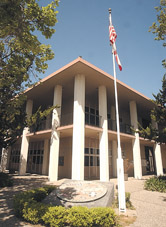Courts to close once a month
The wheels of justice will turn a bit slower starting next month
as the San Benito County Courthouse shuts its doors Sept. 16 as
part of a state-mandated monthly closure in response to California
budget cuts.
Courts to close once a month
The wheels of justice will turn a bit slower starting next month as the San Benito County Courthouse shuts its doors Sept. 16 as part of a state-mandated monthly closure in response to California budget cuts.
The state’s Judicial Council recently voted to close every court in the state on the third Wednesday of every month to help shore up a $414 million budget gap in the court system. The move, which is expected to continue at least through June 2010, is expected to save $85 million this fiscal year.
“We’re fairly busy and we have a fairly full calendar,” said Superior Court Judge Steven Sanders. “If we have to reduce any of our time in court it’s going to have a negative impact on the access to justice. We’re going to try to minimize that but at the same time we recognize that there’s a gap in the funding, not only in the courts but statewide. We’re prepared to do our share to address the economic situation.”
The statewide closures are a response to a funding cut that began when the state Legislature voted to reduce the amount of money given to the judicial branch, according to Gil Solorio, San Benito County’s executive officer for the superior court.
“The Judicial Council then passed that along and authorized the court closure,” he said. “It’s very regrettable. Access to justice is being impaired and we’re affecting employees and the public.”
The monthly court closure could affect approximately 35 county employees at the Fifth Street facility, Solorio said, noting that “the details about the impact still have to be negotiated” with the union representing those employees.
Unlike other court employees, Sanders and Judge Harry Tobias cannot be forced to take a pay cut because they are constitutional officers of the state. However, Sanders said the judges plan to voluntarily take the one-day cut in pay per month as a sign of solidarity with their colleagues.
The impact of the court closure remains to be seen, though Sanders said that during the weeks when the court has the Wednesday closure, some people awaiting their time in court will have to wait longer than normal.
“We won’t be able to pull people in from the jail to arraign them or to reduce bail or to O.R. (release them on their own recognizance) them,” he said. “The net effect of this closure is that if you get arrested on a Monday during the week of a court closure and normally would have come into court on a Wednesday, you’ll spend another day in jail. That’s just a natural consequence of closing that Wednesday.”
The local court is revamping its entire calendar of scheduled court times to address the monthly closure, Sanders said.
“I do felonies on Wednesdays so we have to move those to different days,” he said. “I’m then taking drug court and moving it to another day and I’m squeezing other calendars to make it all fit. Judge Tobias in civil court will move things around. We only have one court reporter that has to be spread between our two departments.”
The schedule change will force some juggling of the court interpreter’s time, Sanders said, calling the issue “a domino effect.”
“We’re going to have less time to do the same amount of cases,” he said.
The court closures will help close the budget shortfall, though Sanders said “it will still not bridge the entire gap in shortages we face this year.”
Asked whether he anticipates the monthly court closures to continue beyond June, Sanders said, “It’s difficult to say that in nine months we’ll hear reports out of Sacramento that there’s no more fiscal problem, so we expect the stresses of the state’s finances will continue through this year and into next year at least.”
Solorio said local and state court officials are projecting the economic crisis to affect court funding for another two to three years.
“We’re figuring out how we need to adjust to make it to the end of it,” he said.










